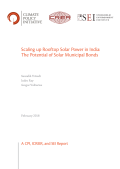Water Use in India’s Power Generation: Impact of renewables and improved cooling technologies to 2030 analyses the prospective impact of renewable energy deployment, along with recently mandated changes to power plant cooling systems, on water use in India’s electricity sector. Looking at the expected freshwater intensity of non-hydro power generation under different scenarios, the analysis aims to quantify the impact of India’s energy transition on freshwater use. The findings highlight the need to incorporate water considerations into energy planning.
The World Resources Institute and the International Renewable Energy Agency (IRENA) conducted the analysis using data compiled from various sources on water withdrawal and consumption. The study considers the impact on water use in the context of IRENA’s REmap India analysis as well as power-sector scenarios from India’s Central Electricity Authority (CEA). The resulting brief focuses on India’s power generation at the national level.
Research increasingly demonstrates the benefits of integrating gender considerations into the energy value chain and throughout the power sector. When the barriers that prevent women from having equal access to energy and economic opportunities are removed, significant productivity gains are unlocked, thereby strengthening development and economic outcomes. Additionally, women are transforming the energy sector in their roles as energy entrepreneurs, innovators and decision makers.
In addition to an overview and evidence of benefits, Advancing Gender in the Environment: Making the case for women in the energy sector identifies the ways in which women are driving the growth of the renewable energy sector and presents a global overview of best practices and solutions that remove barriers to participation. A list of recommendations with links to resources for stakeholders, including policymakers and practitioners, is provided at the end.
Key Messages

The landscape of renewable energy finance has evolved rapidly. Since 2012, renewable power capacity installations have exceeded non-renewables by a rising margin, representing about 60% of all new power-generating capacity added worldwide in 2016. Investment reached a comparable milestone in 2015, when renewable power technologies for the first time attracted more finance than non-renewable power technologies, a trend that has continued subsequently.
Global Landscape of Renewable Energy Finance analyses the renewable energy finance landscape. It outlines key trends globally in 2013-2016, regionally and by technology, examines the differing roles and approaches of private and public finance, highlights the important role of risk mitigation instruments, and provides an outlook for renewable energy finance in 2018 and beyond.
